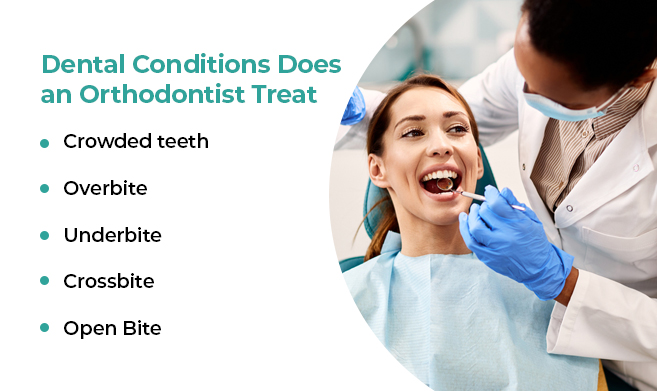All about Legacy Orthodontics
All about Legacy Orthodontics
Blog Article
More About Legacy Orthodontics
Table of ContentsThe smart Trick of Legacy Orthodontics That Nobody is Talking AboutThe Definitive Guide for Legacy OrthodonticsNot known Incorrect Statements About Legacy Orthodontics The 2-Minute Rule for Legacy OrthodonticsHow Legacy Orthodontics can Save You Time, Stress, and Money.
In addition, we supply adjustable treatment schedules, versatile settlement options and an enjoyable, pleasurable experience.An orthodontist is a dental practitioner educated to detect, avoid, and treat teeth and jaw irregularities. Orthodontists function with people of all ages, from children to grownups.
Malocclusion, or misaligned teeth, can lead to dental issues, including tooth decay, gum disease, and hard or agonizing chewing. Not everyone is birthed with straight teeth. If you have a poor bite or large areas between your teeth, you might wish to consult a dental professional specializing in orthodontic treatment.
Top Guidelines Of Legacy Orthodontics
( Image Credit Rating: DigitalVision/Getty Images) Orthodontists use fixed and detachable dental devices, like braces, retainers, and bands, to change the position of teeth in your mouth. Orthodontic treatment is for dental abnormalities, including: Uneven teethBite problems, like an overbite or an underbiteCrowded teeth or teeth that are too much apartJaw misalignmentThe goal of orthodontic treatment is to improve your bite.
A healthy and balanced bite ensures you can eat, eat, and talk correctly. While you may consider orthodontists as mostly for kids or young adults that require dental braces, they can fix oral problems at any age. Orthodontists participate in college, oral school, and orthodontic college. After college graduation, they spend 2 or 3 years in an orthodontic residency program.
All orthodontists are dentists, yet not all dental practitioners are orthodontists. Orthodontic residency programs use extensive, concentrated instruction for oral professionals. They concentrate on 2 locations: Exactly how to effectively and safely relocate teeth Exactly how to properly direct growth in the teeth, jaw, and faceOnce an orthodontist has finished training, they have the choice to become board licensed.
Some Known Details About Legacy Orthodontics
Malocclusion leads to tooth overcrowding, a twisted jaw, or irregular bite patterns. Malocclusion is typically treated with: Your orthodontist affixes metal, ceramic, or plastic square bonds to your teeth.
If you have only small malocclusion, you may have the ability to make use of clear dental braces, called aligners, rather than conventional dental braces (https://sketchfab.com/legacyortho). Some individuals need a headgear to aid move teeth into line with stress from outside the mouth. After braces or aligners, you'll need to wear a retainer. A retainer is a personalized gadget that maintains your teeth in position.
They're usually used on children. They can create extra space in the mouth without having to pull teeth. If you have a significant underbite or overbite, you may need orthognathic surgery (likewise called orthodontic surgical treatment) to lengthen or reduce your jaw. Orthodontists make use of wires, medical screws, or plates to support your jaw bone.
You may need to see an orthodontist if you have: Crowding or not enough space for all of your teethOverbite, when your top teeth come over your base teethUnderbite, when your base teeth are too much forwardSpacing or problems with gapsCrossbite, which is when your upper teeth fit behind your base teeth when your mouth is closedOpen bite or a vertical void between your front base and top teethMisplaced midline, when the facility of your bottom and top teeth don't line up Remedying a dental malocclusion can: Make biting, eating, and talking easierImprove the symmetry of our face and your overall appearanceEase discomfort from temporomandibular joint problemsDifferent your teeth and make them simpler to cleanse, helping prevent dental caries or cavities It's often a dental professional who first notices misaligned teeth during a routine exam.
The Greatest Guide To Legacy Orthodontics

During your very first orthodontic assessment, you'll likely have: An oral examPhotos taken of your face and smileDental X-raysPanoramic (360 degree) X-rays of your face and headImpressions to produce mold and mildews of your teethThese tests will aid your orthodontist recognize how to proceed with your therapy. orthodontics. An orthodontist is a dental professional who's had training to treat your teeth and jaw
An orthodontist is concentrated on your bite, so something like a damaged tooth would be handled by a dentist. Orthodontists are concentrated on your bite, or the way your teeth fit together, and the straightness of your teeth.
Ever questioned just how celebrities always appear to have perfectly lined up teeth? Orthodontists are oral professionals who focus on remedying abnormalities in the teeth and jaws.
Top Guidelines Of Legacy Orthodontics

While dental braces are the most generally recognized orthodontic therapy, orthodontists have a diverse toolkit at their disposal. The specific approach picked depends on the seriousness of the case, the click here for more patient's age, and private preferences. These tried-and-true braces utilize a system of brackets bonded to the teeth and attached by cables.
These removable trays are customized to considerably move the teeth's position. In cases of slim jaws, palatal expanders can be utilized to create area for proper tooth placement.
Report this page